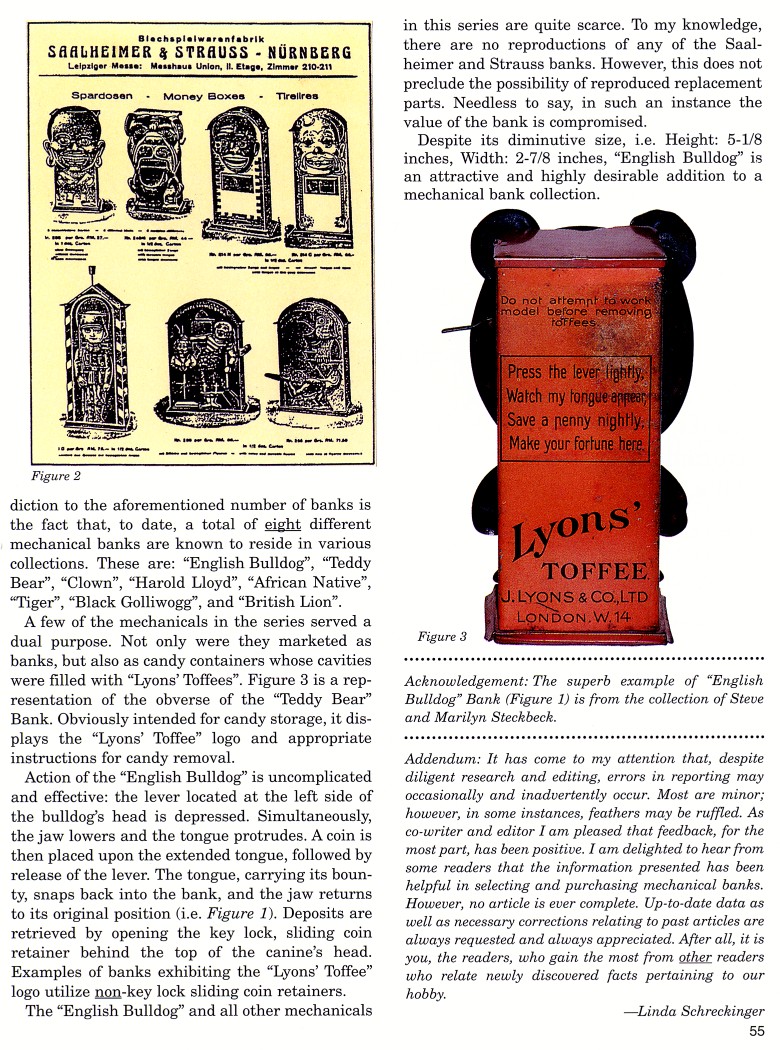|
English Bulldog
by Sy Schreckinger – ANTIQUE TOY WORLD Magazine – August, 2001
What worthier, more befitting, subject for
mechanical banks than the stately Bulldog! A noble creature endowed with a
distinctive jaw, it appears aptly designed by Mother Nature to consume
large amounts of coinage.
Apparently, nineteenth century toy manufacturers were cognizant of
the canine's capability to enhance their line of "penny gobblers".
Familiar examples include "Bulldog Standing" Bank (refer to Antique Toy
World article, February 1990), "Bulldog Coin On Nose" (August 1989),
"Bulldog Savings" (November 1984), "Spring-Jawed Bulldog" (June 1990), "Bonzo"
Tin Bank (August 1997), "Boy and Bulldog" (July 1989), "John Bull's Money
Box", and the subject of this article, "English Bulldog" (Figure 1).
The "English Bulldog" Bank was manufactured by the Saalheimer and
Strauss Tin Works Company of Nurnberg, Germany. Nurnberg was the world
center for the manufacture of tin plate toys during the late nineteenth
and early twentieth centuries. Saalheimer and Strauss was indisputably,
the foremost designer and producer of tinplate mechanical banks during
that era. The skill and artistry demonstrated in their full color,
lithographed, embossed tinplate creations remain unrivaled to this very
day.
Figure 2 represents a flyer distributed in 1929 by Saalheimer and
Strauss. The descriptive caption beneath the catalog illustration of the
"Bulldog" Bank is, interestingly, inscribed in German, English, and
French. It appears likely that the entire series was manufactured for
export to other countries.
Included within the flyer (Figure 2) is a statement indicating the
bank shown in Figure 1 was part of "a series of six tin mechanicals
produced with and without animation". However, in contradiction to the
aforementioned number of banks is the fact that, to date, a total of eight
different mechanical banks are known to reside in various collections.
These are: "English Bulldog", "Teddy Bear", "Clown", "Harold Lloyd",
"African Native", "Tiger", "Black Golliwogg", and "British Lion".
A few of the mechanicals in the series served a dual purpose. Not
only were they marketed as banks, but also as candy containers whose
cavities were filled with "Lyons' Toffees". Figure 3 is a representation
of the obverse of the "Teddy Bear" Bank. Obviously intended for candy
storage, it displays the "Lyons' Toffee" logo and appropriate instructions
for candy removal.
Action of the "English Bulldog" is uncomplicated and effective: the lever
located at the left side of the bulldog's head is depressed.
Simultaneously, the jaw lowers and the tongue protrudes. A coin is then
placed upon the extended tongue, followed by release of the lever. The
tongue, carrying its bounty, snaps back into the bank, and the jaw returns
to its original position (i.e. Figure 1). Deposits are retrieved by
opening the key lock, sliding coin retainer behind the top of the canine's
head. Examples of banks exhibiting the "Lyons' Toffee" logo utilize
non-key lock sliding coin retainers.
The "English Bulldog" and all other mechanicals in this series are
quite scarce. To my knowledge, there are no reproductions of any of the
Saalheimer and Strauss banks. However, this does not preclude the
possibility of reproduced replacement parts. Needless to say, in such an
instance the value of the bank is compromised.
Despite its diminutive size, i.e. Height: 5-1/8 inches, Width: 2-7/8
inches, "English Bulldog" is an attractive and highly desirable addition
to a mechanical bank collection.
Acknowledgement: The superb example of "English Bulldog" Bank (Figure
1) is from the collection of Steve and Marilyn Steckbeck.
Addendum: It has come to my attention that, despite diligent
research and editing, errors in reporting may occasionally and
inadvertently occur. Most are minor; however, in some instances, feathers
may be ruffled. As co-writer and editor I am pleased that feedback, for
the most part, has been positive. I am delighted to hear from some readers
that the information presented has been helpful in selecting and
purchasing mechanical banks. However, no article is ever complete.
Up-to-date data as well as necessary corrections relating to past articles
are always requested and always appreciated. After all, it is you, the
readers, who gain the most from other readers who relate newly discovered
facts pertaining to our hobby.
—Linda Schreckinger
|


